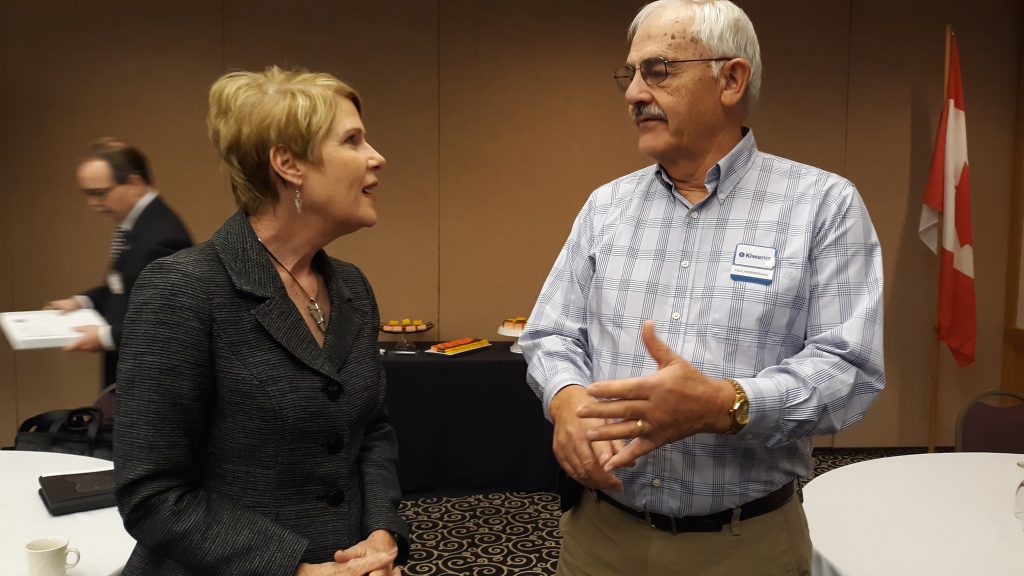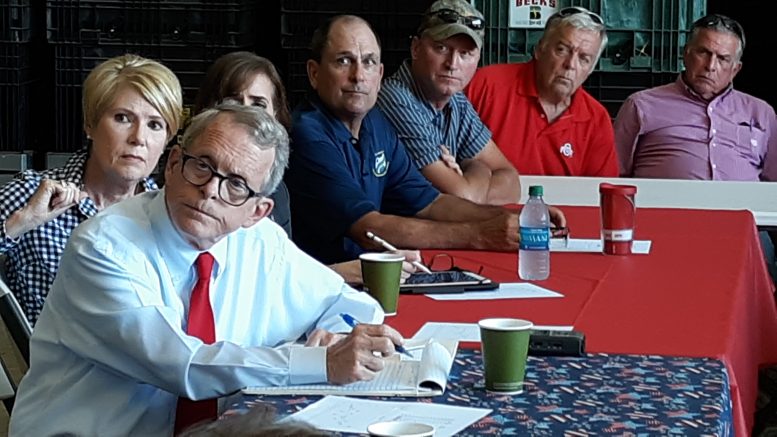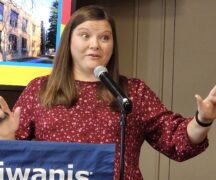By JAN LARSON McLAUGHLIN
BG Independent News
When Ohio Department of Agriculture Director Dorothy Pelanda talks with farmers, she doesn’t come off as some city slicker afraid to get her hands – and boots – dirty.
“I live on the family farm where I was raised,” Pelanda said Thursday to the Bowling Green Kiwanis Club.
So when she talks about the need for farmers to help protect the state’s water, she has some credibility. She recalled as a child, her family’s farm pond sometimes looked like “something out of a horror movie.”
“We learned the things we were doing with our grain fields were having an effect on the water,” Pelanda said.
Those concerns have grown over the years as nutrient runoff from agriculture has been proven to be the primary cause for harmful algal blooms in Lake Erie and elsewhere. So last year, the state adopted the H2Ohio plan, which is intended to be a comprehensive proposal – dealing with the hazardous algal blooms in the lake, but also with failing septic systems in rural areas, and with contaminated water caused by lead piping.
The goal is to devise a long lasting answer to the green goopy water that can be harmful to humans, to tourism, and to economic development in the region.
Three state departments have been charged with coming up with ways to improve water quality, Perlanda said, and given funding to do so:
- $46 million to the Ohio Department of Natural Resources to create programs for the rehabilitation of state wetlands.
- $8.6 million to the Ohio Environmental Protection Agency to deal with failing septic systems, primarily in rural areas of the state.
- $30 million to the Ohio Department of Agriculture to sign up farmers and acreage to be part of the H2Ohio program.
The H2Ohio program has established 10 “best practices” that farmers can adopt.
“It has to start with science,” Pelanda said on Thursday.

A team originally looked at 300 practices to reduce the amount of phosphorus draining off fields into ditches and streams – ultimately making it to Lake Erie. Those were narrowed down to the 10 most cost effective practices for farmers.
The H2Ohio program will help farmers fertilize in a way safer for the environment and more cost effective for them. The key is putting the right fertilizer on at the right time, in the right place, at the right rate. Of course, if it were that easy, farmers would already be hitting all those goals.
So the H2Ohio plan offers help and incentives to farmers who follow the “best practices” set by the state.
The plan stops short of making the steps mandatory for farmers. Farmers will receive incentives for adopting the steps suggested by the state, and will save money by not flushing fertilizer into the lake.
The “best practices” in H2Ohio include efforts such as soil testing, variable-rate fertilization, subsurface nutrient application, conservation crop rotation, and edge-of-field buffers.
Farmers in the 14 counties of the lower Maumee River basin are being asked to sign up for the program. Wood County is included in that group. Participants will be eligible for shares of the $30 million to help reduce agricultural runoff and keep algal blooms out of Lake Erie.
Local farmers can apply starting on Feb. 1 with the Wood Soil and Water Conservation District. An informational meeting will be held Feb. 4, at 3 p.m., at Owens Community College’s Veterans Hall 33035 Oregon Road.
The results of H2O will not be immediate – not even close, Pelanda cautioned.
“This is a learning process. The first two years are probably going to be the toughest. In two years, we will be able to say – here are the number of acres we’ve been able to sign up in these counties,” she said. “The commitment of the farmers is going to be the most successful approach.”
But the work must begin now.
“We have an obligation, not only to ourselves, but for the next generations to do the right thing,” Pelanda said.
Pelanda was in Wood County last year when heavy and frequent rains kept many farmers from planting their fields. She and Gov. Mike DeWine visited the farm of Kris Swartz in Perrysburg Township – where farmers from the region came to discuss their plight.
“As we watched the excessive rain in the spring,” Pelanda said she knew farmers would need help. At her own farm, in Union County, the rains kept her family from getting tractors in the fields.
For the first time ever, the entire state of Ohio was declared a disaster by the U.S. Secretary of Agriculture.
Perlanda, said she has been surprised by some of her responsibilities as Ohio director of agriculture.
“Who knew that I would be in charge of” commercial dog breeding, fuel stickers on gas pumps and rides at the state fair, she said.
She shared with the Kiwanis Club her plan to turn the 120-acre Ohio Department of Agriculture campus back into a working farm – so school bus loads of students can come learn where food comes from.





